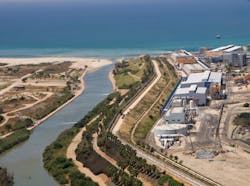Mega Projects: Is Size Everything in Desalination?
Larger scale desalination plants are coming online as a result of increased water scarcity and lower cost membranes. With the largest facility in the world – 1,025,000 m3/day – set for operation in 2014, what challenges and benefits come with such large scale infrastructure? Corrado Sommariva reports.
There is a lot of emphasis today on mega ton water systems. This trend is clearly driven by the gigantic development of cities. The number of cities that will exceed five million residents in 2015 is going to be in the order of magnitude of 40-50. Clearly, in such an environment, water shortages and the pollution of water resources become serious problems.
Taking into consideration that the majority of these cities are located close to the sea and in arid areas, desalination plants assume extreme importance and are, in fact, critical strategic assets necessary for the community to sustain and support life.
Although large plants may offer opportunities in terms of economy of scale, there is a question as to whether the mega solution is automatically the best option. This is especially true in the case of Seawater Reverse Osmosis (SWRO) plants.
While large unit size is typically an advantage for thermal desalination, the modularity of the SWRO technology makes it practically insensitive from the cost standpoint if the plant capacity is greater than 100,000 m3/day. This feature allows two advantages. The first benefit is that the plant can be designed for installation in more decentralized locations closer to the utility point, therefore decreasing the associated transmission and distribution costs and the energy footprint.
A second advantage is that the risk profile of a medium- to large-sized project is clearly more moderate than the risk profile of a mega ton project. This becomes an important factor in addressing the difficulty in securing the necessary level of investment associated with such developments in the current and near-term financial climate.
The particular advantage of SWRO is that it allows modularity of installation, whereby an infrastructure designed for long-term expansion could be enlarged gradually and according to the demand for
additional capacity. In this scenario, limited recourse or non recourse loans could be easily made available for small- to mid-size plants. This type of investment presents a much more moderate risk profile and could be revisited for expansion or reduction in size in accordance with demand development. However, producing this large amount of water imposes again, and with a much higher emphasis, the necessity to meet the dual objectives of a sustainable management of water resources and high competitiveness
Putting this into context, if we think about the large numbers, the operation of a mega SWRO desalination plant (for example, capacity of 1,000,000 m3/day) would involve a quantity equivalent to three to four million m3/day of seawater abstracted from the sea, and two to three million m3/day of brine disposal discharging back to the sea. With today's state-of-the-art technologies, the energy required to power this plant would be equivalent to 200 MW.
Things change dramatically if we think about a similar size plant driven by thermal technology. This would involve a quantity equivalent to eight to 10 million m3/day of seawater abstracted from the sea and seven to nine million m3/day of brine disposal with a thermal discharge. In this case, the energy required to drive this plant would be equivalent to 1,500 MW.
However, the majority of this energy – 1,000 to 1300 MW – would be discharged as low grade heat into the sea.
Both scenarios pose dramatic questions on the environmental load related to mega ton water projects and energy conservation.
If addressing the environmental aspect is a clear goal, today's technology would not enable the installation of such facilities for less than US$1 to 2 billion per mega project, with estimated annual running costs of not less US$200,000,000 per plant. This is not an easy deal for today's market.
Our generation needs to be aware that building plants to simply satisfy our water needs for tomorrow is not enough. Now is the time now that we must contribute to solving global water problems by establishing novel desalination and water treatment technology that would enable us to achieve the ultimate goal of solving the global water-energy-food problem.
However, we are still far from this situation. Mega projects are a solution for today and perhaps tomorrow, but we need to act to ensure that the day after tomorrow we have a solution at hand that is revolutionary if we compare it to the traditional approach.
Desalination is a fast-moving and dynamic industry as far as research and development is concerned. There are countless papers on the advantages of: Forward osmosis; Carbon nanotubes; Membrane distillation; Biomimetics and Renewable water generation associated to LT distillation or renewable power.
In reality, however, the chance of having one of these technologies installed and operating in one of the future mega projects is very slim. While we are currently installing projects on a "need oriented" drive, we need to "seed drive" the technologies that are going to make these projects viable In the future. We cannot delegate this work to future generations; the time available is short. We need to have a set of small to medium size plants online by 2014-2015 in order to have a sustainable mega project operational in 2020.
This will also be needed to have a bank that will be willing to finance a deal with some of the new concepts that the research and development sector is now cultivating.
These plants will need to be capable of validating the technology, providing feedback to operation and further design refinement. All stakeholders need to be engaged in this endeavor. The government needs to have a solution that is going to address long-term problems in a financially and environmentally sustainable way without compromising the robustness and consistency of the solution.
The importance of this approach needs to be understood and embraced at all levels and all stakeholders need to follow up on this call. Industry and developers need to find ways to invest in these solutions with an equitable distribution of risks between themselves. Banks must also find investment in new water technologies a reasonable deal – as was the case with investing in new renewable power generation technologies a long time ago.
There is a lot of work needed to make sure that desalination is "a promise for the future". However, it is a promise that can be kept if all stakeholders are willing to think ahead and recognize the potential of new configurations, new technologies and new shared responsibilities for addressing our future water challenges.
Author's note: Dr. Corrado Sommariva is President of the International Desalination Association (IDA). He can be reached at [email protected]. For more information about IDA, visit www.idadesal.org.


